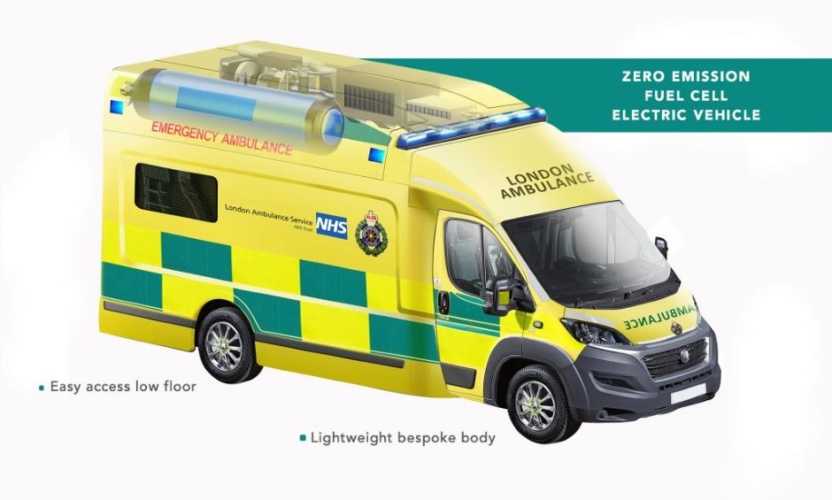A project led by hydrogen fuel specialists ULEMCo is aiming to deliver the UK’s first zero emission hydrogen ambulance later this year.

Named ZERRO (Zero Emission Rapid Response Operations), the project is funded by the Office for Zero Emission Vehicles (OZEV). ULEMCo is collaborating with the London Ambulance Service NHS Trust (LAS) and several manufacturing partners. With a design now agreed, the team is progressing to the build stage and expects to deliver a prototype for LAS by autumn.
The ambulance will incorporate a hydrogen fuel cell range extender with an electric drive, low-frame chassis and bespoke ambulance body designed and manufactured by Woodall Nicholson Group‘s Mellor, VCS Limited and Promech Technologies. Lyra Electronics will bring specialist DC-DC electronics capability, and Ocado will bring experience of light-weighting and practical use of electric vehicles.
Working in line with CEN (the EU standard for ambulances), and national ambulance specifications, the team was required to overcome several design challenges such as ensuring there was enough internal space to allow for upright standing, building the hydrogen system into the roof of the vehicle, and implementing a low-access floor removing the need for patient lifting equipment.
Amanda Lyne, managing director of ULEMCo explained that introduction of a hydrogen ambulance fleet could provide a more viable solution to the NHS in instances where charging requirements of an electric vehicle would be impractical, particularly in rural areas of the country.
Aberdeen rolls out world’s first hydrogen double decker
Collaboration aims for autonomous hydrogen fuel-cell vehicles
“The project was originally applied for with Yorkshire Ambulance Service, but for local reasons the London Ambulance team were really driven to take ownership of it, partially because of the mayoral requirement on their objectives with air quality,” Lyne said. She added that the LAS may be able to use battery for a proportion of its fleet, due to shorter routes and less hills than in rural areas, but that this would require testing.
In addition to charging implications Lyne also pointed out the impact of payload and hotel load on battery, and the importance of considering the daily range choices an ambulance needs when carrying onboard equipment, crew members and potentially more than one patient. “If you take into account all of the payload requirements, putting a lot of batteries on wouldn’t work – but if you put one single battery in because you have a shorter route, that ambulance is then restricted to the shorter route and if they needed to go from one hospital to another, they’d need flexibility,” she added.
Whilst fuel cells initially more costly than a current diesel fleet, Lyne said that our need for zero emissions vehicles is the most important issue and that diesel should no longer be the benchmark. She added that through the team’s bespoke frame approach there is opportunity for minimal waste during the build process and that the cost target will be approached from a total cost of ownership basis, taking into account factors such as energy used to manufacturing and maintenance.
“This project is a key part of our strategy for a zero emission fleet, to support the NHS aim to be the world’s first net zero national health service, and to meet or exceed the clean air requirements in London,” commented Chris Rutherford, head of Fleet Strategy & Transformation at LAS.
The post Hydrogen ambulance set for London appeared first on The Engineer.


